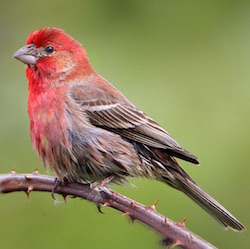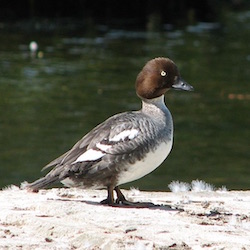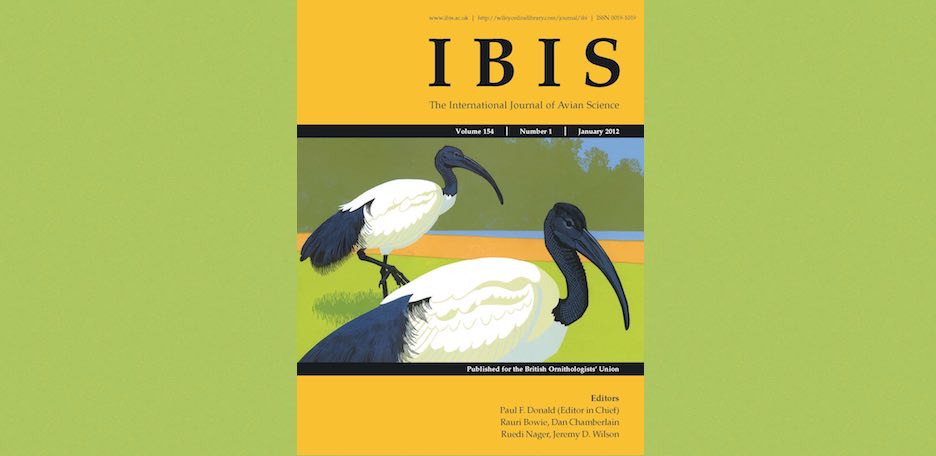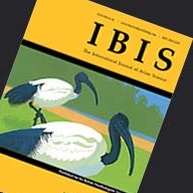VIEW – current issue | VIEW – all issues
April 2019 | Vol. 161, issue 2
The latest issue of our 2019 volume contains a Review paper, 13 Original articles, 6 Short Communications and a Viewpoint article; plus the return of our regular book reviews!
Here are just four of the many highlights in this issue.
Review Article Seabird ecology
- A review of the occurrence of inter‐colony segregation of seabird foraging areas and the implications for marine environmental impact assessment
Mark Bolton, Georgia Conolly, Matthew Carroll, Ewan. D. Wakefield, Richard Caldow Recent advances in bio‐logging technology have resulted in a rapid increase in studies of seabird movement and distribution. In this review, Mark Bolton and co-authors from the Royal Society for the Protection of Birds, University of Glasgow and Natural England, UK, found that inter‐colony foraging area segregation of seabirds occurred in 79% of 39 studies. The frequency of occurrence was similar across the four seabird orders for which data were available, and included species with both smaller (10–100 km) and larger (100–1000 km) foraging ranges. Bolton et al. reveal that many predictions of a density‐dependent hinterland (DDH) model were confirmed, with examples of segregation in response to high levels of inter‐colony competition related to colony size and proximity, and enclosed landform restricting the extent of available habitat. Inter‐colony overlap occurred where birds aggregated in highly productive areas, often remote from all colonies. From this review, Bolton et al. conclude that current impact assessment approaches for marine development that do not consider spatial inter‐colony segregation will be subject to error. Their recommendations are that tracking data should be collected from multiple colonies and modelling of inter‐colony interactions are needed to predict colony‐specific distributions.View
Recent advances in bio‐logging technology have resulted in a rapid increase in studies of seabird movement and distribution. In this review, Mark Bolton and co-authors from the Royal Society for the Protection of Birds, University of Glasgow and Natural England, UK, found that inter‐colony foraging area segregation of seabirds occurred in 79% of 39 studies. The frequency of occurrence was similar across the four seabird orders for which data were available, and included species with both smaller (10–100 km) and larger (100–1000 km) foraging ranges. Bolton et al. reveal that many predictions of a density‐dependent hinterland (DDH) model were confirmed, with examples of segregation in response to high levels of inter‐colony competition related to colony size and proximity, and enclosed landform restricting the extent of available habitat. Inter‐colony overlap occurred where birds aggregated in highly productive areas, often remote from all colonies. From this review, Bolton et al. conclude that current impact assessment approaches for marine development that do not consider spatial inter‐colony segregation will be subject to error. Their recommendations are that tracking data should be collected from multiple colonies and modelling of inter‐colony interactions are needed to predict colony‐specific distributions.View
Original Article: Species interactions
-
- The effect of beaver facilitation on Common Teal: pairs and broods respond differently at the patch and landscape scales
Petri Nummi, Eeva‐Maria Suontakanen, Sari Holopainen, Veli‐Matti Väänänen Beavers enhance waterfowl habitats by impeding water flow and creating temporary flooding. Petri Nummi and colleagues from the University of Helsinki, Finland investigated how these changes to the ecosystem influenced the production of Common Teal in two areas of southern Finland with and without introduced American Beavers. Interestingly, brood density was 60-90% greater in beaver patches and landscapes, and beaver presence also influenced pair density of Teal at the landscape level. Nummi et al. conclude that ecosystem engineering by the beaver could be used as an effective restoration tool in areas where high‐quality habitats are needed for waterfowl.View
Beavers enhance waterfowl habitats by impeding water flow and creating temporary flooding. Petri Nummi and colleagues from the University of Helsinki, Finland investigated how these changes to the ecosystem influenced the production of Common Teal in two areas of southern Finland with and without introduced American Beavers. Interestingly, brood density was 60-90% greater in beaver patches and landscapes, and beaver presence also influenced pair density of Teal at the landscape level. Nummi et al. conclude that ecosystem engineering by the beaver could be used as an effective restoration tool in areas where high‐quality habitats are needed for waterfowl.View
- The effect of beaver facilitation on Common Teal: pairs and broods respond differently at the patch and landscape scales
Short communication: Breeding biology
-
-
- Temperature‐correlated shifts in the timing of egg‐laying in House Finches Haemorhous mexicanus
Heather E. Watts, Daniela Jimenez, Veronica Pacheco, Tauras P. Vilgalys - Much of what we know about temperature‐correlated shifts in the timing of egg‐laying
 comes from studies of European species with animal‐based diets during breeding. In this study, Heather Watts and collaborators from Washington State and Loyola Marymount Universities, USA, therefore wished to find out if the relationship between temperature and laying differed with diet. They did this by examining reproductive timing in House Finches Haemorhous mexicanus, a North American species that breeds on a primarily seed‐based diet. Using nest records from California spanning more than a century, Watts et al. found that overall egg‐laying occurred earlier in warmer springs: a 4.6 day advancement per °C, agreeing with previous findings on other species elsewhere. What was clear however, was that this effect was not uniform across the region, as the timing of egg‐laying did not show long‐term changes in most of California, but only in the hottest region of the state.View
comes from studies of European species with animal‐based diets during breeding. In this study, Heather Watts and collaborators from Washington State and Loyola Marymount Universities, USA, therefore wished to find out if the relationship between temperature and laying differed with diet. They did this by examining reproductive timing in House Finches Haemorhous mexicanus, a North American species that breeds on a primarily seed‐based diet. Using nest records from California spanning more than a century, Watts et al. found that overall egg‐laying occurred earlier in warmer springs: a 4.6 day advancement per °C, agreeing with previous findings on other species elsewhere. What was clear however, was that this effect was not uniform across the region, as the timing of egg‐laying did not show long‐term changes in most of California, but only in the hottest region of the state.View
- Temperature‐correlated shifts in the timing of egg‐laying in House Finches Haemorhous mexicanus
-
Viewpoint: Impacts of climate change
-
-
- Climate‐change not only threatens bird populations but also challenges our ability to monitor them
Anthony D. Fox, Rasmus Due Nielsen, IB Krag Petersen Arctic ecosystems are warming and in this thought-provoking Viewpoint Anthony Fox and colleagues from Aarhus University, Denmark highlight that this has consequences for waterfowl in high latitudes but it also has implications for long term monitoring programmes. Northern European studies show recent north and eastern shifts in the wintering distributions of diving ducks. Open water in the Russian Arctic offers novel overwintering habitat especially for sea ducks, but also for other species far to the north and east of their former wintering range. Fox et al. argue convincingly that these climate change effects are a major challenge for surveying the distribution and abundance of many of our common ducks, and new technologies and survey coverage are urgently required for future monitoring.View
Arctic ecosystems are warming and in this thought-provoking Viewpoint Anthony Fox and colleagues from Aarhus University, Denmark highlight that this has consequences for waterfowl in high latitudes but it also has implications for long term monitoring programmes. Northern European studies show recent north and eastern shifts in the wintering distributions of diving ducks. Open water in the Russian Arctic offers novel overwintering habitat especially for sea ducks, but also for other species far to the north and east of their former wintering range. Fox et al. argue convincingly that these climate change effects are a major challenge for surveying the distribution and abundance of many of our common ducks, and new technologies and survey coverage are urgently required for future monitoring.View
- Climate‐change not only threatens bird populations but also challenges our ability to monitor them
-
Other items
Book reviews
Contents
Sign up for content e-alerts
Image credits
Common Guillemot | Michael Haferkamp | CC BY SA 3.0 | Wikimedia Commons
Common Teal | J M Garg | GFDL | Wikimedia Commons
House Finch | nigel | CC BY 2.0 | Wikimedia Commons
Common Goldeneye | Atıf-Benzer Paylaşım | GFDL | gag.wikipedia.org





